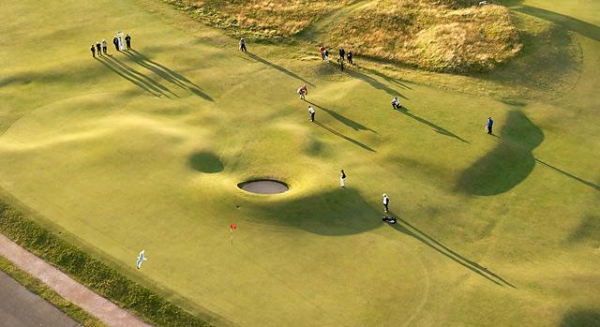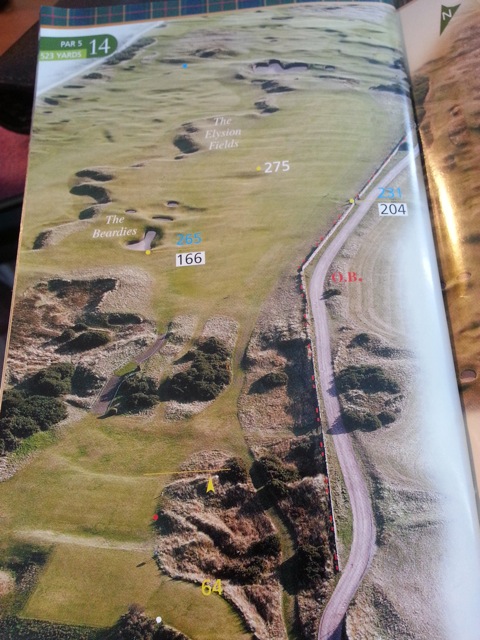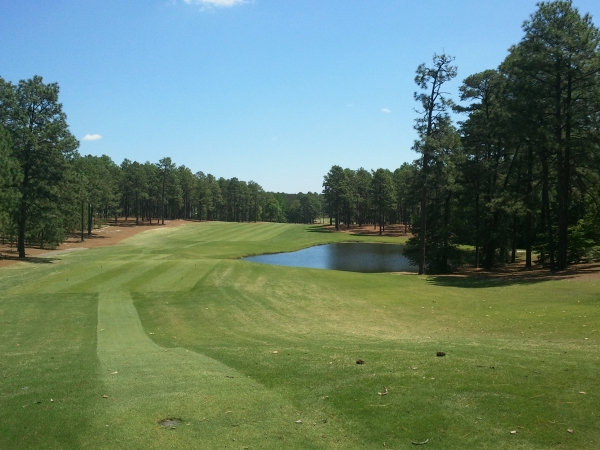Is There a Silver Bullet in Golf Course Architecture?
As you might imagine, architects get pressed quite often to profess our opinions about what makes one golf course better than another. And while I think that is more an individual preference (or left to magazines), there are some courses that stand out among the rest. But why? Is it their great beauty? Is it the impeccable maintenance? Is it the dramatic routing of holes on interesting terrain? Well…. perhaps all of the above contribute in some way, along with many other elements. If pushed though, the question remains, what characteristic stands out most that allows some courses to be really great? It might sound limiting and basic, but my answer is, WIDTH - the space in which we are provided to play the game.
Width allows for many options at St. Andrews
For whatever reason, I have given this a fair bit of thought. Not because I’m looking for the silver bullet or other golden idiom, per se – but perhaps there are some parallels that can help us understand and better communicate what makes a golf course great. I’m not aware of or even bold enough to think that there is a for sure, bona fide panacea that translates to great golf – it’s a little silly to even think so. But, there does seem to be one element that, interestingly, seems to have a lot in common with many other random influences we seek to address on our courses today.
When there is an appropriate width in which to play golf, I believe, this is when all the other elements have the best chance to come together more cohesively. With ample space, we can provide playing options… especially in the wind. Some of the greatest golf experiences I’ve had were on very difficult courses, but they were wide and provided alternative routes of play…. courses like St. Andrews, Ballyneal and Pacific Dunes, for example – and many courses in the British Isles. Even when the wind is howling, there is room to hit a shot, find it and chart an alternative path toward the green without the penalty of a lost ball or going out of bounds.
One would not realize that this hole at CCNC is surrounded by homes
I’ve also had the opportunity to design and play many courses that are laid out within a golf community – holes that are cramped; bordered by roads and homes. Trust me… that is not the most conducive environment to create or enjoy a great golf experience. In fact, it’s quite the challenge - mainly because there can be a lack of width. After all, that extra space we are yearning for on the golf course is costing the developer millions if not developed for real estate. Still, he wants us (golf) there – he needs us there, to help him sell those lots as a backdrop and amenity for his entire real estate venture. But when we do have the ability to create golf in a spacious corridor, then elements of option and intrigue can surface, not to mention factors of safety and security. At the Country Club of North Carolina, for example, the corridors are so spacious, buffered by the pines and homes set well back from the golf. The same effect is achieved well at Muirfield Village in Ohio – the width allows for better golf to be developed.
And what about tree lined courses, you say? Yes, trees can complicate width for sure. Those same, beautiful trees that we all love and protect are also hindering the turf quality on the course, as well as circulation, playability and many of the strategic elements that would otherwise be effective if not for the encroachment of vegetation. As Donald Ross once said, “As fond as you and I are of them (trees), we still must not lose sight of the fact that there is a limited place for them in golf.” And if we look at his masterpiece at Pinehurst, the #2 Course exudes what a wider, tree-lined golf corridor should look like… all perfectly framed by majestic pines, but in a way that does not interfere with the game itself.
A spacious golf hole can be enjoyed…. It can be made to be very strategic, with multiple playing options. It can be savored during challenging conditions, such as heavy wind or during droughty times when the ground is firm and running. It can be a beautiful space, without homes and other elements that smother its boundaries. A spacious golf hole can be better maintained, with open sunlight and movement of air. Width also allows for more of our frequent playing errors. After all, we just need the opportunity to find that little white ball and hit it again without delay.
Just thinking about some of the best courses versus the average ones. Better courses have holes that meander; they have strategic angles with interesting hazards that guard routes of play. Rarely have we recognized greatness in holes that are "bowling alley" straight. In fact, straight holes tend to be narrower and have penal strategies, which is to say they tend to have hazards on both sides of the holes without any true "bailout" options. Width allows for such elements to be integrated - and to me, it seems that brand of golf is much preferable to the latter.
Width is sometimes a scarce commodity on our golf courses – which is why I tend to enjoy most those courses where there is ample room to play, room to err and room to make choices. Some of the best courses in the world also have some of the widest fairways…think of National Golf Links of America, Pine Valley, Augusta National (until the more recent changes) and The Old Course at St. Andrews.
Width promotes use of ground contours; makes golf more dynamic
 As an architect, all I can hope of a property is the space in which to be creative. Width allows for more incorporation of subtle design features and, with the proper soils, more intriguing forms that influence the ground game. This brand of golf is inspiring to play because it is so distinctive; so playable and rewards creativity by the golfer.
As an architect, all I can hope of a property is the space in which to be creative. Width allows for more incorporation of subtle design features and, with the proper soils, more intriguing forms that influence the ground game. This brand of golf is inspiring to play because it is so distinctive; so playable and rewards creativity by the golfer.
So when it comes down to it, those tight, narrow courses with trees and deep rough may challenge the best in the world for four days, but they’re not always the most enjoyable – or adaptable for the rest of us under varied conditions. That’s why I say we need a game that is more fun and WIDTH seems to have a major role in making golf enjoyable – AND great.
Tags
Classic Courses , Country Club of North Carolina , Course Design , Course Rankings , Design Elements , Enjoyable Golf , Golf and the Landscape , Golf Course Architecture , Golf Course Communities , Golf Course Design Trends , Golf Course Development , Golf Course Improvements , Golf Course Maintenance , Links Golf , Making Golf More Fun , North American Courses , Old Course - St. Andrews , Pinehurst #2 , Speed of Play , Strategic Options , Why Golf is Fun , Width and golf ,



Comments